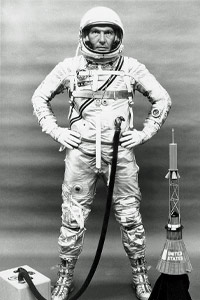How to Build a Better Space Explorer

In space, nothing mechanical or biological works quite the way it’s supposed to. Fuses malfunction, and welding torches throw off dangerous globs of hot metal. Body odor and bad breath hang around. Food and filth float. In this unforgiving environment, even snoring poses a potential threat, robbing crewmates of vital sleep. Every day in space is like finals week, only the consequences of failing are substantially worse.
NASA engineers can account for every ounce of crew, fuel and cargo on their ships, but they’re powerless to control emotional baggage. No fabricated valve exists that can regulate the emotional pressure that builds throughout a long space mission.
Lengthy space excursions take a substantial physical toll as well. Near Earth, weightless astronauts suffer bone loss and muscular atrophy, experience higher than normal radiation levels and face a higher risk of kidney stones. Once we send voyagers beyond Earth’s protective magnetic shield, they’ll occupy a much hotter and more temperamental radiation zone.
Physical shielding will likely prove impractically heavy, but technology might suggest other solutions. Building a faster spaceship would decrease radiation exposure; it would also reduce food and water weight, thereby cutting costs. NASA might also develop a new technology that repels cosmic rays. Such solutions probably lie far in the future, however.
Rather than wait, some scientists suggest sending colonists on a one-way trip to the red planet. Paul Davies of Arizona State University and Dirk Schulze-Makuch of Washington State University, in a 2010 article in the Journal of Cosmology, estimated that nixing return fuel and supplies could save 80 percent of the cost of a Mars mission. The article’s publication brought postcards from more than 1,000 volunteers, even though no such mission exists [sources: Kaufman; Klotz].
That pioneering spirit will constitute a vital core value for any near-future space colonist, but guts and gusto alone will not be enough. Space programs already set strong baseline requirements for space travelers, but a crewed trip to another planet will take them deep into uncharted waters.
When the sky’s the limit, what should we look for in astronaut candidates? If the technology becomes available, should we choose astronauts with a genetically lower risk of radiation-related health problems? Could we train people from childhood to be better adapted, mentally and physically, to life in space?
How far might we be willing to go to conquer the great unknown? Perhaps even to the point of changing what it means to be human?
Contents
Ticking the Boxes to Be an Astronaut
Taking a Physical Toll
Somebody’s Got a Case of the Mondays
Space Madness
In Space, Hell Is Other People
We Have Met the Enemy, and It Is Us
Author’s Note
Ticking the Boxes to Be an Astronaut
When composing a checklist for future space explorers, it’s a good idea to first consult the folks who spent more than 50 years defining “the right stuff.” NASA no longer uses the shuttle-era roles described below, but many of the basic requirements and skill sets remain unchanged for missions aboard the International Space Station (ISS). It makes sense. After all, the space shuttles, once launched, essentially acted as temporary space stations [source: Ross].
In the early days of the space program, NASA chose rocketeers according to their guts, quick wits and piloting skills. The agency also required them to have bachelor’s degrees in math, engineering or science. In the later Apollo missions, NASA folks expanded their selection criteria to include non-test pilots with advanced degrees [source: Ross]. Harrison Schmitt of Apollo 17, a civilian with a doctorate in geology from Harvard University, logged more than 301 hours of spaceflight and 22 hours of extravehicular activities (EVAs) [source: NASA].
With the advent of the shuttle program, space travel became more about return trips, construction and experimentation, which made room for a wider range of abilities and demanded a broader array of skills. As of 2004, NASA had three kinds of astronauts — commander/pilot, mission specialist and payload specialist — each with different requirements. With the space shuttle retired, these designations could change to match the space agency’s evolving mission.
Traditionally, pilots and commanders controlled their vehicles, helped deploy or retrieve satellites and aided in payload operations. The job required a bachelor’s degree in engineering, biological science, physical science or mathematics, and 1,000 hours of pilot-in-command time in jets. It also required 20/100 vision (correctable to 20/20), blood pressure of 140/90 and a height of 62-75 inches (157.5-190.5 centimeters) [source: NASA]. Killer moves on the dance floor? Sadly, not a requirement.
Mission specialists coordinated systems, crew activities, consumables, experiments and payload. They also performed EVAs and operated remote manipulators. Applicants needed a bachelor’s degree as above, as well as three years of related professional experience, depending on their degree level. Their physical standards were more relaxed, however: 20/200 vision (correctable to 20/20), blood pressure of 140/90 and a height of 58.5-76 inches (149-193 centimeters) [source: NASA].
Payload specialists were not NASA astronauts per se; for example, they might be a teacher, a senator or a foreign dignitary. They had to receive a nomination from NASA, a foreign sponsor, or whoever sponsored the payload in question, and needed to possess appropriate education and training, meet certain physical requirements and pass NASA’s space physical [source: NASA].
In 2012, America’s space program sends similar personnel to the ISS but aboard Soyuz rockets with different physical requirements.
Just as NASA’s requirements for its space travelers changed as its missions evolved, the ideal candidate for long-term explorer or colonist might require reimagining the ideal astronaut. The one thing that won’t change? The necessity that candidates possess physical toughness and mental mettle equal to the task.
MILITARY PILOT = AWESOME ASTRONAUT?
NASA has always drawn heavily from military pilots. They’re a good fit, and not only because of their piloting skills, affinity for derring-do and ability to make snap decisions under pressure. They’re also conditioned to follow orders, used to spending long stretches away from family and accustomed to cramped quarters with little privacy.
Taking a Physical Toll
Space is not a friendly place.
In fact, space travel abounds with health risks, mostly caused by radiation and weightlessness. Space travelers risk bone and muscle loss, cataracts, kidney stones, vertigo, motion sickness, low blood pressure and cancer, to name but a few prevalent perils [sources: NASA; Roach].
Astronauts orbiting Earth on the International Space Station (ISS), around 250 miles (400 kilometers) up, experience roughly 10 percent less gravity — or would, were they not in near-weightless free fall. The moon exerts 16.6 percent of Earth’s gravity; Mars gravity stacks up to only about 37.7 percent [source: NASA].
Yes, NASA is the easiest and most guaranteed weight-loss program out there. It’s also the most difficult to get into but, at a cost of only tens of millions of greenbacks spent per astronaut, it’s still cheaper than Jenny Craig.
Like that weird kid sitting in the back of homeroom eating his fingernails, the human body likes to consume unneeded bits of itself. For space travelers, that poses a problem, because — while they remain weightless — much of their muscle and bone mass fall into the “surplus” category.
Microgravity exposure affects the body like a Charles Atlas ad in reverse. Astronauts struggle to stay ripped — and fight bone loss — using exercise, but research suggests that missions lasting longer than 180 days render this effort moot. The silver lining? Losses, which occur rapidly in the initial stages of reduced gravity, plateau after six months [source: Fitts].
Exercising in microgravity is about as efficient as doing underwater pushups. Weight machines must generate inertia using flywheels, and treadmills must hold astronauts down with awkward, chafing tethers that apply only 70 percent of their body weight [sources: Roach; Wall]. Astronauts already spend about 2.5 hours per day, six days a week, exercising during a six-month stay aboard the ISS. Longer missions will require getting more out of those hours, not adding to them [source: Wall].
Astronauts experience bone density loss rates comparable to, or worse than, post-menopausal women (1-2 percent per month with exercise), particularly in the large weight-bearing bones (pelvis, hips, legs). Back on Earth, recovering bone mass and volume can take much longer than the mission itself; even then, bones remain less dense and more porous, and non-load-bearing areas might never fully recover [sources: NASA; Nimon; Roach]. Space, like old age, is not for wimps.
As bones break down, they release calcium into the blood and urine, increasing the risk of kidney stones. Astronauts can kill two birds with one renal calculus using bisphosphonates, or osteoporosis drugs. Bed rest tests — used on Earth as a stand-in for zero gravity — have yielded positive results, and an ISS study was under way as of April 2012 [source: NASA].
Bisphosphonates have been linked to necrosis of the jawbone, however, which might influence future use [source: Merigo; Roach]. Or not. Space, after all, is a hostile place. Going there requires balancing risks and for many, the ticket’s worth the price.
Radiation-induced cataracts aren’t the only threat to astronauts’ peepers [source: NASA]. Time spent weightless compresses eyeballs, puffs up optic nerves and distorts vision. These effects can persist long after returning home. More time spent in space, as on a Mars jaunt, increases the likelihood of permanent vision problems or even blindness. Solutions might include generating artificial gravity by spinning all or part of the spacecraft or treating the causes with drugs [source: Chang].
All of that fuss and bother, and we haven’t even made planetfall.
Once on Mars, explorers would confront frigid temperatures and an unbreathable carbon dioxide atmosphere too thin to protect against radiation. Travelers might harvest water from the poles or from subsurface ice, but colonists would need to grow their own food [source: Kaufman].
Sound daunting? Don’t worry. There’s a good chance you’ll crack up before you even get there.
MY GOD, IT’S FULL OF STARS
Astronauts aboard Skylab, the space shuttle, Mir and the ISS have reported experiencing strange flashes of light seemingly emanating from inside their eyeballs. These flashes are caused by radiation striking their retinas, generating a signal that fools the brain.
Somebody’s Got a Case of the Mondays
Being an astronaut is awesome. It’s also awesomely hard, as Clay Anderson here can probably attest. Anderson was waving to the camera after a session of EVA outside the International Space Station in 2007.
Being an astronaut is awesome. It’s also awesomely hard, as Clay Anderson here can probably attest. Anderson was waving to the camera after a session of EVA outside the International Space Station in 2007.
IMAGE COURTESY NASA
If space were not so incredibly awesome, going there would really suck. You have to be “on” all the time, dealing with conditions best described as hot, close, smelly, dirty and noisy, all while being stressed and sleep-deprived. It’s unending, and you don’t dare flinch, lest the folks back at mission control boot you or scrub the mission, so you become skilled at displacing or repressing your anger. Meanwhile, you’re dealing with the frustration of equipment, weightlessness and possibly cultural and language barriers.
You can’t quit; you can’t go home; you can’t even crack a window.
Under such conditions, the best of us can keep our heads for a few days or even weeks. Give it a couple of months, though, and we start imploding into depression or exploding with anger — which raises the question: What about years? What about when your crew finds itself alone in the black, or on some distant world where they can barely pick Earth out of the star field?
NASA has a history of selecting steely-eyed missile men (and women) based on guts, instincts and reactions under pressure. With the dawn of the shuttle era, NASA added one more requirement: a knack for tolerating boredom and low levels of stimulation [source: Roach]. You have plenty to do — mission control lays tasks out in an unbroken series of 15 to 20 minute time slots — but flipping toggles or tightening bolts, even in space, can’t quite compete with test-piloting an experimental fighter [source: NASA].
Perched on the shoulder of every astronaut is a tiny devil called Frustration, and he grows a little bigger with every task performed in cramped, weightlessness conditions. On spacewalks, they must struggle with weightlessness, bulky space suits and awkward, pressurized gloves that tire out their hands within minutes, all while their air supply ticks down and they hover on the precipice of doom. Handling such pressures long term, even inside the ship, requires a different level of cool than most of us possess.
Although some astronauts say weightlessness becomes natural after a week, it never stops causing petty annoyances. Without gravity, dust doesn’t settle; nor does spilled food, drink, vomit or excrement. You can’t just put something down — you must tether it to a hook or Velcro it to a surface. Without weight, you must concentrate just to hold an object, and if you let it go, it might drift off, never to be found. Relearning how to use eating utensils and a bathroom: It’s like going through preschool all over again.
This constant vigilance, and these minor annoyances, add up to seriously frayed nerves, setting the stage for rage, panic, jumpiness and a whole host of related stress reactions.
In some cases, they’ve pushed spacers over the edge.
Space Madness
In a classic episode of “Ren & Stimpy,” Ren cracks up during a 36-year space mission, ultimately devouring a bar of soap he mistakes for a coveted ice cream bar. The cause? Too much eating food from a tube and too much time alone with the wrong traveling companion (not that Ren was very stable to begin with).
The exacting conditions of space travel inevitably produce stress. When combined with the nerve-fraying effects of myriad hindrances and trying circumstances, stress eventually leads to breakdown. After all, human beings evolved to tolerate stressful episodes, but only ones broken up by periods of rest and relaxation.
Space programs are understandably careful about divulging momentary lapses of reason, as are astronauts and cosmonauts, but memoirs and interviews reveal that they have occurred.
After six months in the Greyhound-bus-sized Mir space station in 1987, Aleksandr Laveykin returned to Earth early, later admitting to suffering acute depression and suicidal thoughts. His partner, Yury Romanenko, stayed behind but grew ever more testy and withdrawn. His crewmates took over communications with mission control [source: Roach].
Cosmonauts Boris Volynov and Vitali Zholobov returned early from Soviet space station Salyut 5 after a terrifying incident drove Zholobov to the verge of breakdown. On the 42nd day, while in the Earth’s shadow, they lost all electricity. Imagine it: No lights; no pumps; no communications with ground; no sense of up or down; no way to see controls or switches; only as much oxygen as already filled the station. After an hour and a half, they managed to restore power, but the incident took its toll: Zholobov could no longer sleep. He complained of splitting headaches (possibly due to the air being contaminated). He had to come down [source: Roach].
Even ignoring the stress of environmental hostility or imminent catastrophe, living with frustration and without many options for emotional support or release cannot help but erode mental well-being. Many of us consider ourselves cool-headed, but how well would we do without our prized possessions, go-to entertainment or closest loved ones?
And then there’s the elephant in the room: Libido. Let’s face it: Motivated humans can stave off hormonal urges for a brief period, but not for years or a lifetime. Perhaps the time will come when we assume a less puritanical “position” on the subject. Some astronauts and cosmonauts advocate letting crews engage in nonmonogamous relationships and … activities … as a way to ease tensions (NASA discourages married couples on missions, both to prevent conflicts of interest and to avoid the possibility of inflicting a double loss on their children). The idea isn’t without precedent: Many Antarctic researchers gain emotional support by forming season-long sexual relationships [source: Roach].
Sexy and single or chaste and content: Either way, if you’re planning to join the mission, you’d better be good at making friends.



 Creators of mankind
Creators of mankind Description of “Tall white aliens”
Description of “Tall white aliens” Where they came from?
Where they came from? About hostile civilizations
About hostile civilizations The war for the Earth
The war for the Earth “Tall white aliens” about eternal life
“Tall white aliens” about eternal life Video: “Nordic aliens”
Video: “Nordic aliens” Aliens
Aliens Alien encounters
Alien encounters The aliens base
The aliens base UFO
UFO Technology UFO
Technology UFO Underground civilization
Underground civilization Ancient alien artifacts
Ancient alien artifacts Military and UFO
Military and UFO Mysteries and hypotheses
Mysteries and hypotheses Scientific facts
Scientific facts


















